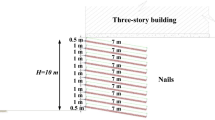Abstract
Site response analysis is usually the first step of any seismic soil-structure study. Geotechnical earthquake engineers and engineering geologist have been trying to find both practical and most appropriate solution techniques for ground response analysis under earthquake loadings. The paper attempts to give a critical overview of the field of site response analysis. In this paper, the influences of nonlinearity on the site response analysis summarized and were evaluated with a numerical example. Site response of a two layered soil deposit with the assumption of linear and rigid base bedrock (or viscoelastic half-space) was analyzed by using linear and nonlinear approaches. The amplification spectrum of the soil column is computed between the top and the bottom of this soil deposit. Nonlinear analysis was compared with the linear method of analysis. Steps involved in ground response analyses to develop site-specific response spectra at a soil site are briefly summarized. Some of the well-known site response analysis methods are summarized and similarities and differences between linear and nonlinear methods are compared by a numerical example.











Similar content being viewed by others
References
Bardet JP, Tobita T (2001) NERA: a computer program for nonlinear earthquake site response analyses of layered soil deposits, Department of Civil Engineering, University of Southern California, Los Angeles, CA, 43 pp
Bardet JP, Ichii K, Lin CH (2000) EERA: a computer program for equivalent–linear earthquake site response analyses of layered soil deposits, Department of Civil Engineering, University of Southern California, Los Angeles, CA, 37 pp
Boatwright J, Fletcher JB, Fumal TE (1991) A general inversion scheme for source, site, and propagation characteristics using multiply recorded sets of moderate-sized earthquakes. Bull Seismol Soc Am 81:1754–1782
Borcherdt RD (1970) Effects of local geology on ground notion near San Francisco Bay. Bull Seismol Soc Am 60:29–81
Borja RI, Chao H-Y, Montans FJ, Lin C-H (1999) Nonlinear ground response at Lotung LSST site. J Geotech Geoenviron Eng 125(3):187–197
Field EH, Jacob KH (1995) A comparison and test of various site-response estimation techniques, including three that are not reference-site dependent. Bull Seism Soc Am 85:1127–1143
Field EH, Johnson PA, Beresnev IA, Zeng Y (1997) Nonlinear ground-motion amplification by sediments during the 1994 Northridge earthquake. Nature 390:599–602
Field EH, Kramer S, Elgamal A-W, Bray JD, Matasovic N, Johnson PA, Cramer C, Roblee C, Wald DJ, Bonilla LF, Dimitriu PP, Anderson JG (1998) Nonlinear site response: where we’re at. Seismol Res Lett 69:230–234
Finn WDL et al (1978) Comparison of dynamic analysis of saturated sand. Proc ASCE GT Spec Conf, pp 472–491
Huang HC, Shieh CS, Chiu HC (2001) Linear and nonlinear behaviors of soft soil layers using Lotung downhole array in Taiwan. Terr Atmos Ocean Sci 12:503–524
Hwang HHM, Lee CS (1991) Parametric study of site response analysis. Soil Dyn Earthq Eng 10(6):282–290
Idriss IM, Sun JI (1992) User’s manual for SHAKE91: a computer program for conducting equivalent linear seismic response analyses of horizontally layered soil deposits. Center for Geotechnical Modelling, Department of Civil and Environmental Engineering, University of California
Iwata T, Irikura K (1988) Source parameters of the 1983 Japan Sea earthquake sequence. J Phys Earth 36:155–184
Joyner WB, Chen ATF (1975) Calculation of nonlinear ground response in earthquakes. Bull Seismol Soc Am 65:1315–1336
Kramer SL (1996) Geotechnical earthquake engineering. In: Prentice-Hall international series in civil engineering and engineering mechanics. Prentice-Hall, New Jersey
Lam I, Tsai CF, Martin GR (1978) Determination of site dependent spectra using nonlinear analysis. In: 2nd international conference on microzonation, San Francisco, CA
Lermo J, Chavez-Garcia FJ (1993) Site effects evaluation using spectral ratios with only one station. Bull Seismol Soc Am 83:1574–1594
Nakamura Y (1988) On the urgent earthquake detection and alarm system (UrEDAS). In: Proceedings of World Conference in Earthquake Engineering
Rodriguez-Marek A, Williams JL, Wartman J, Repetto PC (2003) Southern Peru Earthquake of 23 June, 2001: Ground motions and site response, Earthquake Spectra. 19A:11–34
Schnabel PB, Lysmer J, Seed HB (1972) SHAKE: a computer program for earthquake response analysis of horizontally layered sites. Report No. EERC72-12, University of California, Berkeley
Seed HB, Idriss IM (1970) Soil moduli and damping factors for dynamic response analysis. Report No. EERC70-10, University of California, Berkeley
Seed HB, Whitman RV, Dezfulian H, Dobry R, Idriss IM (1972) Soil conditions and building damage in the 1967 Caracas earthquake. J Soil Mech Found Div ASCE 98:787–806
Yamazaki F, Ansary MA (1997) Horizontal-to-vertical spectrum ratio of earthquake ground motion for site characterization. Earthq Eng Struct Dyn 26:671–689. JSSMFE: 14–31
Yoshida N (1994) Applicability of conventional computer code SHAKE to nonlinear problem. In: Proceedings of symposium on amplification of ground shaking in soft ground
Yoshida N, Iai S (1998) Nonlinear site response analysis and its evaluation and prediction. In: 2nd international symposium on the effect of surface geology on seismic motion, Yokosuka, Japan, pp 71–90
Author information
Authors and Affiliations
Corresponding author
Rights and permissions
About this article
Cite this article
Arslan, H., Siyahi, B. A comparative study on linear and nonlinear site response analysis. Environ Geol 50, 1193–1200 (2006). https://doi.org/10.1007/s00254-006-0291-4
Received:
Accepted:
Published:
Issue Date:
DOI: https://doi.org/10.1007/s00254-006-0291-4




